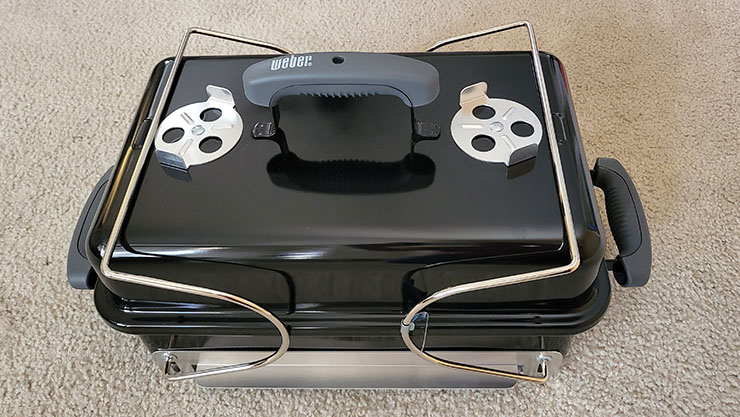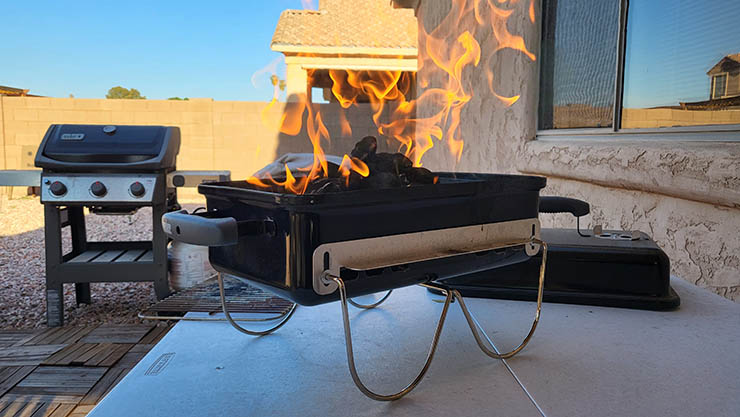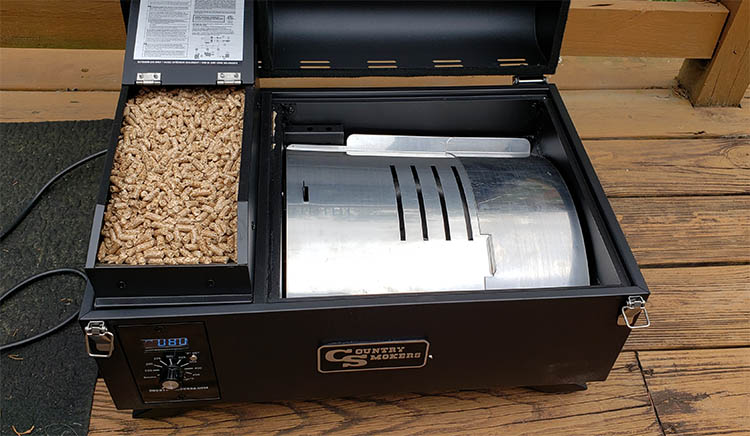Dragging a heavy grill to the campsite or park can turn a fun cookout into a chore. The best portable grills allow you enjoy the same burgers, steaks, and chicken you’d cook at home without the bulk or hassle.
The title of best portable grill wasn’t handed out lightly. We’ve personally tested more than 75 gas, charcoal, and pellet grills, putting each through real-world cooking sessions to see how they perform on heat control, portability, ease of setup, cooking space, and overall build quality.
The 5 Best Portable Grills
In this guide, we’re highlighting our picks for the best portable grills, whether you’re camping, tailgating, or just taking it to the park for a weekend cookout.
Because different grillers have different needs and preferences, we’ve split our recommendations into gas, charcoal, and pellet. Whether you want quick setup and easy temperature control, the smoky flavor of charcoal, or wood-fired cooking on the go, you’ll find a portable grill here to match your style.
1. Best Overall – Weber Traveler Portable Gas Grill
Sure, you can throw a lot of grills in the back of the truck and call them “portable,” but most of the time it’s a hassle. You’ve got to deal with the awkward shapes, flimsy legs, and don’t get me started on the grease that can leak out into your vehicle on the way home from camp.
The Weber Traveler was built from the ground up with portability as its main feature, and it shows in every detail.
Setup is a one-person job. Just pop the handle, step on the leg, lift, lock, and you’re cooking.
We went with a gas grill for our top pick because it’s the most convenient fuel type for portable cooking. It’s quick to light, easy to control, and there’s no messy charcoal to haul or dispose of at a campsite. The Traveler also lets you run either a 1 lb cylinder or a 20 lb tank, so you can match your fuel to the trip.
The cart is solid enough to feel like a full-sized backyard grill, but folds flat to slide easily into your trunk or SUV. I found the slow release folding feature so satisfying I put the grill up and down five times in a row while my wife got the campsite ready and gave me angry looks.
Big wheels roll right over gravel and grass, and the single 320-square-inch cast iron grate gives you enough space for a proper cookout
In our hands-on video review below, you’ll see how quick it is to set up, how it cooks, and a closer look at its portability features in action.
Unlike most portable grills that demand a separate table or expensive stand to make them practical, the Traveler’s sturdy cart is part of the deal. You get comfortable cooking height anywhere you set it up, plus a decent side shelf for your cutting board or tray and hooks for your tools
The 43.6″ width should fit into the back of most SUVs, or smaller cars with a seat folded down. At 49 lbs you won’t be taking this grill hiking. If you’re worried about weight or space Weber sell the Traveler Compact, which is only 32″ wide, although you give up 80 square inches of cooking area.
For our test run, we kept things classic with a couple of grocery store ribeye steaks to see if the cast iron grates could deliver a proper sear. With the grill preheated, we hit 600°F at the hot spot and got some textbook cross-hatch marks in just a few minutes.
We also cooked bacon and pancakes using the griddle attachment.
The Traveler gets portability right with a sturdy built-in cart, quick setup, and solid heat performance. It offers enough cooking space for a family meal and works just as well at home as it does on the road.
Read our full Weber Traveler review.
| Cooking Area | 320 sq in |
| Fuel | 1 lb propane canister (20 lb tank compatible with adapter) |
| Burners | 1 |
| Weight | 49 lbs |
| Dimensions | 37.2″ H × 43.6″ W × 23″ D (open) |
If our top pick, the Weber Traveler, is more than you want to spend, or you prefer the flavor of charcoal, the Weber Jumbo Joe is an excellent alternative, earning the top spot in our best portable charcoal grill roundup.
There’s something about cooking over charcoal at the park, beach, or campsite that just feels right. There’s no knobs to twist, just that slow, smoky magic you only get grilling over briquettes or lump charcoal.
When it comes to charcoal, Weber’s been the benchmark for decades, and the Jumbo Joe continues that tradition. Think of it as the bigger, more cookout-ready sibling to the classic Smokey Joe. You still get the same iconic kettle design with an 18-inch grate that can handle up to eight burgers at once.
Over six weeks of testing, we ran just about everything we could through this little kettle. Steaks, burgers, sausages, pork chops, chicken thighs, even a whole chicken. Where it really shines is searing. Once we got the grill up to 600°F, our sirloins came off with a perfect medium-rare and that deep, flavorful char you only get from charcoal.
With the dampers dialed in, it’ll hold a steady 350°F for roasting. It might take a little practice to figure out the right vent settings, and since there’s no built-in thermometer, you’ll want to use your own BBQ probe to keep an eye on temps.
The Tuck-N-Carry lid lock secures the lid when you’re traveling, and when you’re cooking you can hook it in place upright so the lid works as a windbreak.
Weber also sell the rectangular shaped Go-Anywhere, which is another solid option.
Read our full Weber Jumbo Joe review.
3. Upgrade Pick – Nomad Charcoal Grill & Smoker
If you like the idea of grilling with charcoal, but are put off by the flimsy legs and hot exterior of the Weber Go-Anywhere, the Nomad Charcoal grill is a great upgrade.
The unique suitcase-style design makes the grill easy to transport, and because the exterior doesn’t get hot, you can set the grill up virtually anywhere.
The Nomad is the safest charcoal grill we’ve tested.
When using both sides of the grill you get 425 total square inches of cooking area which is plenty to cook for my family of five. Temperature control is done via two sets of air vents.
The grill grates are magnetic, so you know they are set in place and won’t move around when traveling.
I’ve left my Nomad sitting out in the rain and snow many times, and the weather hasn’t left any noticeable marks.
Read our full Nomad review.
4. Best Electric – Weber Lumin
While we aren’t normally fans of electric grills, we’re willing to concede they’re a good option for a tabletop grill.
We tested out the new Weber Lumin in our best electric grill round-up and were impressed with its ability to grill, smoke, and steam.
While Weber sells a stand attachment, out of the box the Lumin is designed to work on any outdoor table.
With a max temperature of 600°F, you shouldn’t have any issues searing steaks, burgers, and veggies.
The smoke infusion function really sets the Lumin apart. Just remove one of the grill grates add the dry reservoir in the space, and fill it with a handful of wood chips. We made some chicken breasts that had a great smokey flavor.
If you need to cook somewhere that doesn’t allow gas or charcoal or just want the safety and convenience of electricity, the Lumin is a great choice.
Read our full Weber Lumin review.
Best portable pellet grill – Traeger Tailgater
With their bulky hoppers, large insulated cooking chambers and requirement for electricity, pellet grills aren’t the obvious choice for a portable grill.
But if you’re willing to deal with those limitations, they offer some unique advantages which make them perfect grills for camping or taking on the go.
Portable pellet grills fall into two styles. Compact ‘suitcase’ style grills the like Ranger, and more full sized grills, often with foldable legs like our pick the Traeger Tailgater.
The Tailgater keeps most of what people love about Traeger pellet grills but trims the size down to something you can fold up and load in a trunk or truck bed. With 300 square inches of cooking space, it’s big enough for a dozen half-pound burgers, a rack or two of ribs, or a batch of smoked chicken thighs.
It runs from 185°F to 450°F, though it’s happiest cooking above 200°F, where it delivers steady heat and a clean burn.
In our testing, it grilled burgers with juicy, evenly cooked centers and a subtle smoky flavor, and it smoked chicken thighs and ribs with good color and tender texture. It’s easy to clean thanks to removable grates and drip tray, and the 8-lb hopper is enough for shorter cooks without constant refilling.
The folding legs aren’t the easiest to set up solo, and the control panel could be more intuitive, but the Tailgater still cooked more evenly and consistently than other portable pellet grills we’ve tried. If you want wood-fired flavor in a portable package and can live without fancy extras like Wi-Fi, this is the one to get.
The Tailgater runs on standard 120V AC power, so you’ll need access to an outlet or a compatible portable power source. At home or at a powered campsite, that’s as simple as plugging into the mains. For more remote spots, you can use a small generator or an inverter connected to your vehicle’s 12V outlet
What to look for in a portable grill
In the next section, we’ll take a look at some of the important factors when choosing which grill to buy.
You might also want to consider a Hibachi style grill which we cover in a separate guide.
Portability features
Obviously, one of the most important considerations is the portability features.
You’ll want a grill that is lightweight so you can prop them up on tables without too much trouble.
But some grills offer additional useful features like handles and foldable legs for extra portability.

The legs on the Go-Anywhere double as lid locks
In particular, you should try to find handles that are made of some durable material that won’t get too hot during cooking.
Cheap plastic handles are best avoided.
You should also try to find portable grills with foldable legs. Legs that can extend and contract make storing and propping up your tabletop grill easier than otherwise.
This can be especially important if you don’t have a lot of space to store your tabletop grill and need to squeeze it into a shelf. Being able to fold the legs up onto its underside is a great feature.
Some tabletop grills also come with foldable side tables, again to improve storing options, or locking lids. Being able to lock your lid is a great safety feature.
You can prevent charcoal or the grates of your grill (if they are removable) from falling out if you need to move the grill to another location quickly.
Weight and size
Before settling on a grill, check out its weight and think about whether or not you’ll be able to easily carry it from your truck to the cooking site.
Some grills are perfect for crowded picnics and can share a lot of space with other tools or cooking spreads. Others require a lot of space to be used to their maximum effect, featuring extendable side tables or just wide cooking surfaces.
There’s no one perfect weight or size for a tabletop grill. It all depends on your preference and what type of cooking you’ll be doing. Larger sizes are better for serving more people or making more food at the same time, of course.
Fuel type
Don’t forget to think about the fuel type of a given tabletop grill. There are four main types you’ll find: charcoal, propane, pellet and electric. The first three will require you to carry some fuel with you to your cooking site.
Charcoal grills impart a particular flavor to their foods that some chefs really enjoy.

Remember that “flame-grilled” can get you in trouble with the local law
Most propane grills come with a tank sized perfectly for their chassis already, but a few require you to buy adaptors for larger tanks if you want to cook for long uninterrupted stretches.
Propane grills make temperature control easy. But there are plenty of charcoal grills with temperature control features, as well.
The choice is ultimately your own, as neither charcoal nor propane is 100% better than the other.
This is a timeless debate so if you want to learn more check out our full gas vs charcoal guide.
How to use a tabletop grill safely
Tabletop grills can be excellent for cookouts at campsites but there’s a trick to using tabletop grills safely that regular grill users don’t need to consider.
Tabletop grills have to be used on certain surfaces in order to be used safely. Most tabletop grills become extremely hot, and this ambient heat can cause issues depending on the surface you are using to cook.
Our product tester wanted to see how well his plastic picnic table would hold up to the heat from the Weber Go-anywhere…

The heat from your grill can be enough to warp certain materials
Metal is a perfectly safe cooking surface. It would take heat far in excess of what a tabletop grill can produce in order to damage the metal in any significant way.
This makes tailgates or picnic tables that are made of metal perfectly fine for use with tabletop grills.
However, be aware that some metal is painted with a cheap colored film. This paint may flake off or melt to some degree if exposed to the high heat of a typical grilling session.
Wood surfaces are also usually fine for tabletop grill usage. Picnic tables and surfaces of similar thickness are usually made of wood.

This wood won’t easily catch fire even under the high heat of the tabletop grill. It’s still a smart idea to put a small grease catcher beneath the grill to stop the wood from staining, though.
The most worrisome surface to use with a tabletop grill is plastic. Plastic tables, like those frequently used for backyard cookouts or for camping trips, are at a high risk of melting. They can’t be exposed for long to the high heat of a tabletop grill.
Melted plastic can make the cooking surface unstable and cause the grill to tip over, potentially causing a bigger mess or a big accident.
So it might be worthwhile to purchase a cooking surface that is guaranteed to be safe to use. This is more consistent than relying on tables at your location or the equipment of your host.
 Backyard GrillingWeekend WarriorsAdvice from DadBeard GroomingTV Shows for Guys4x4 Off-Road CarsMens FashionSports NewsAncient Archeology World NewsPrivacy PolicyTerms And Conditions
Backyard GrillingWeekend WarriorsAdvice from DadBeard GroomingTV Shows for Guys4x4 Off-Road CarsMens FashionSports NewsAncient Archeology World NewsPrivacy PolicyTerms And Conditions
